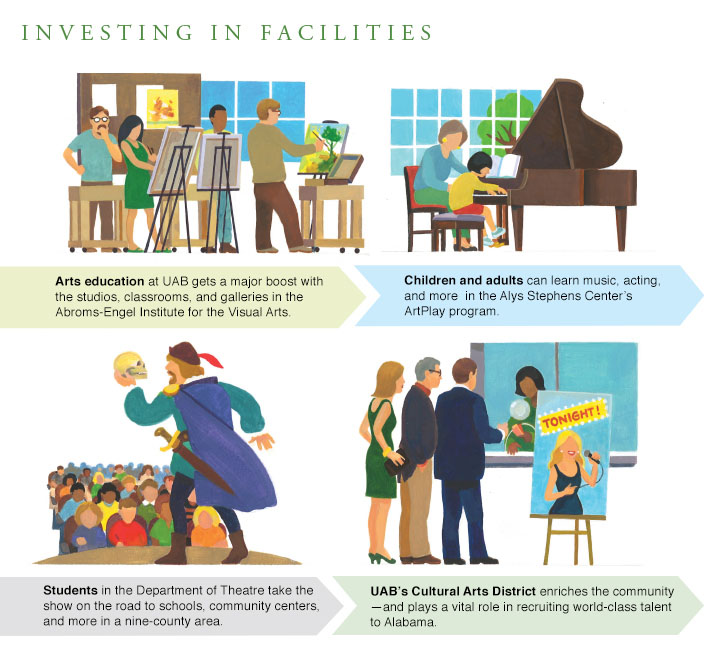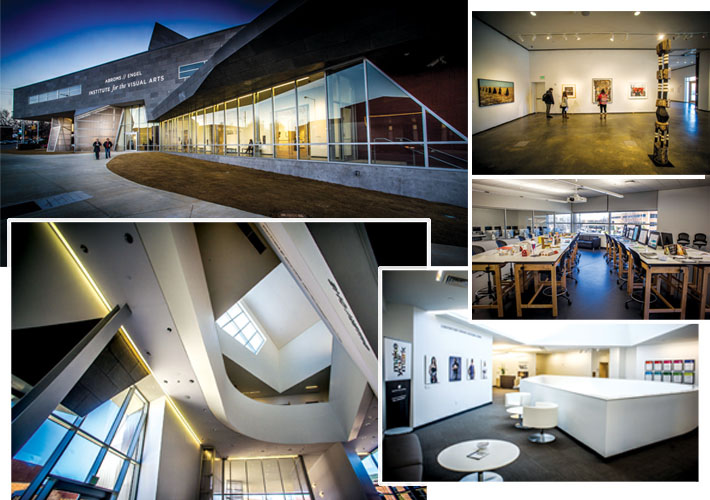
Picture This
Building a Legacy in the Arts
By Matt Windsor • Illustrations by Ernie EldredgeJudy Abroms has a dream. A mother is driving through the UAB campus with her daughter, a high school senior. As they ride down 10th Avenue, “all of a sudden, the student looks around and says, ‘Mom, what’s that?’” Abroms says. “The mother replies, ‘That’s the Institute for Visual Arts.’ And
her daughter says, ‘Gosh, I want to go there.’”
The desire to create a “transformational experience” that could reshape UAB’s campus and attract new generations of students led Judy and Hal Abroms, along with their longtime friends Marvin and Ruth Engel, to make the lead gift to fund the Abroms-Engel Institute for Visual Arts (AEIVA), which opened in January 2014.
“I don’t think we can be a great university without having a strong liberal arts program on campus,” says Hal Abroms. “If we want to really get UAB to that highest level, we have to have a complete university, and that’s what we’re doing with the Institute for Visual Arts. We think this facility is going to attract students who are already here, as well as those who are thinking about coming here. If we can provide a spark and make it possible for students to reach their potential, I just think that’s awesome.”
The 26,000-square-foot AEIVA includes studio laboratories and classrooms for art history, time-based media, and graphic design students. Its three gallery spaces have state-of-the-art security and environmental systems to showcase works from UAB’s permanent collection—including a Pablo Picasso lithograph, Polaroids by Andy Warhol, and an Anthony Caro paper sculpture—and attract new loan opportunities from museums around the world. An outdoor sculpture garden provides another exhibit space.
“The importance of the arts on any campus, regardless of its focus, is that they bring perspective,” says Robert Palazzo, Ph.D., dean of the UAB College of Arts and Sciences. “They are a powerful form of self-discovery, teaching us how to observe and discover the world around us. Without the arts, I don’t think people can be whole.” The AEIVA will attract interest from the community as well as students, Palazzo says. “Our dream is to bring people in touch with world-class art—art that is making us think about who we are and what we represent.”
Arts and culture are an important but often underappreciated facet of business development for Birmingham as well, says Johnny Johns, president and CEO of Protective Life Corporation and a co-chair of The Campaign for UAB. Protective Life “competes for talent all over the United States, and the strong arts and cultural communities that we have in this city are a strong selling point,” Johns says.
By investing in the arts, “you are creating opportunities for your children and grandchildren,” says Theresa Bruno, board president of the Alys Stephens Center and a co-chair of The Campaign for UAB. “We now have in Birmingham the kinds of venues and opportunities to experience art and culture that we used to think we had to travel to find.”
“The arts define a city,” Abroms agrees. “Birmingham has the Alabama Symphony, the Birmingham Museum of Art, the Alys Stephens Center, and now the Institute for Visual Arts. I’ve met professors who have been recruited from places like Harvard and Johns Hopkins, and everyone I talk to is excited about living in Birmingham.”
 |
|
The Abroms-Engel Institute for the Visual Arts includes studios, classrooms, state-of-the-art galleries, and an outdoor sculpture garden. |
Get Involved
• Give something and change everything for the arts at UAB and in Birmingham.
• Learn more about The Campaign for UAB and how it will transform our community.
